Leadership Analysis: Management Theory and Practice, Commonwealth Bank
VerifiedAdded on 2020/05/28
|6
|1422
|66
Essay
AI Summary
This essay delves into the realm of leadership within Commonwealth Bank, exploring the essential aspects of organizational leadership and its practical applications. It examines the significance of leadership in addressing ethical issues, fostering effective communication, and achieving organizational goals. The paper defines leadership as a social exchange and analyzes its fundamental nature, highlighting the importance of adapting to change, being aware of environmental factors, and motivating teams. The essay also discusses ethical leadership, its role in influencing moral development, and the importance of leaders aligning their behavior with team members to solve issues effectively. The conclusion emphasizes the need for ethical leadership to navigate dilemmas and uphold ethical values, ultimately influencing employee behavior and promoting organizational success.

Running head: MANAGEMENT THEORY AND PRACTICE
Management Theory and Practice
Name of the Student
Name of the University
Author note
Management Theory and Practice
Name of the Student
Name of the University
Author note
Paraphrase This Document
Need a fresh take? Get an instant paraphrase of this document with our AI Paraphraser
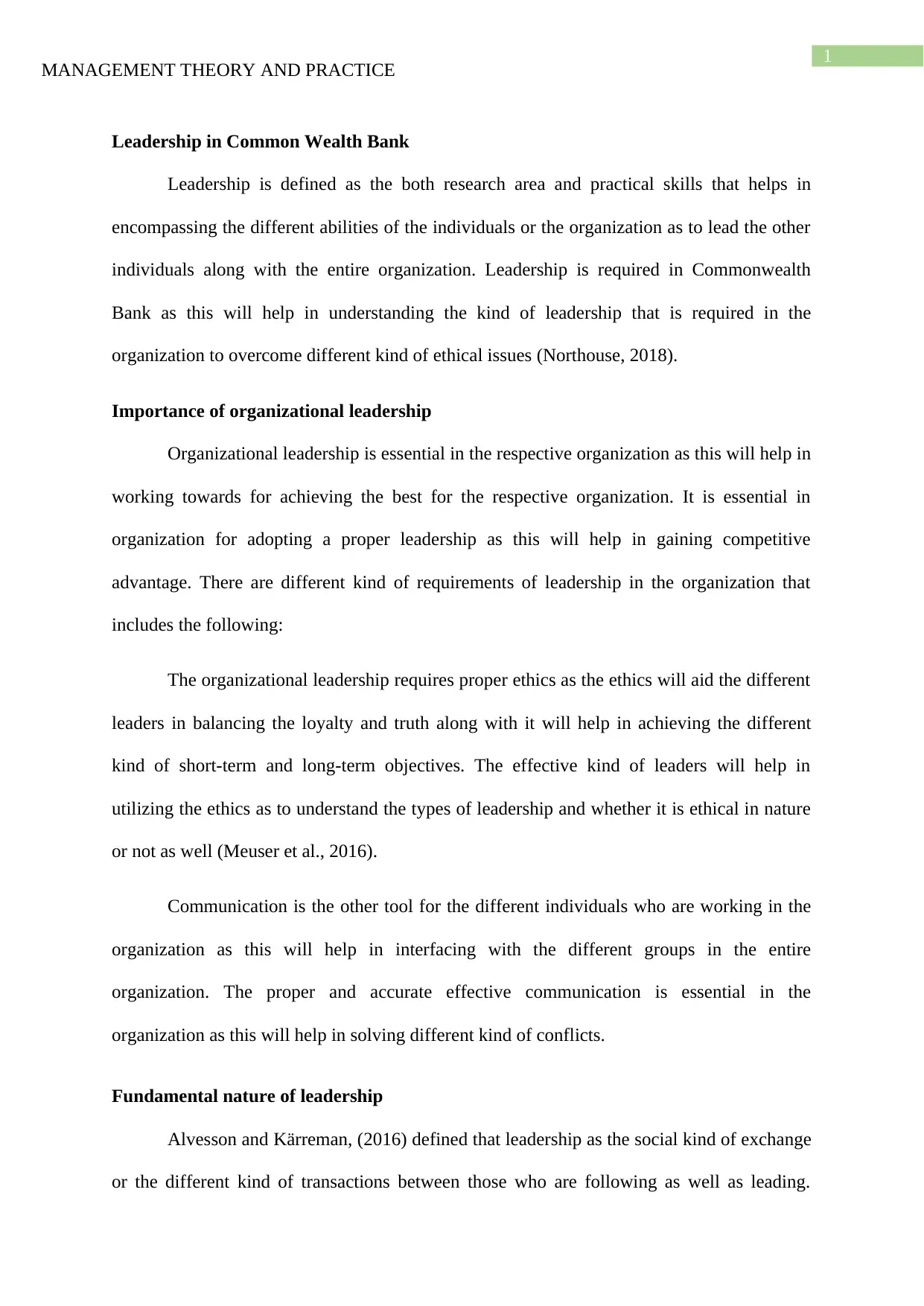
1
MANAGEMENT THEORY AND PRACTICE
Leadership in Common Wealth Bank
Leadership is defined as the both research area and practical skills that helps in
encompassing the different abilities of the individuals or the organization as to lead the other
individuals along with the entire organization. Leadership is required in Commonwealth
Bank as this will help in understanding the kind of leadership that is required in the
organization to overcome different kind of ethical issues (Northouse, 2018).
Importance of organizational leadership
Organizational leadership is essential in the respective organization as this will help in
working towards for achieving the best for the respective organization. It is essential in
organization for adopting a proper leadership as this will help in gaining competitive
advantage. There are different kind of requirements of leadership in the organization that
includes the following:
The organizational leadership requires proper ethics as the ethics will aid the different
leaders in balancing the loyalty and truth along with it will help in achieving the different
kind of short-term and long-term objectives. The effective kind of leaders will help in
utilizing the ethics as to understand the types of leadership and whether it is ethical in nature
or not as well (Meuser et al., 2016).
Communication is the other tool for the different individuals who are working in the
organization as this will help in interfacing with the different groups in the entire
organization. The proper and accurate effective communication is essential in the
organization as this will help in solving different kind of conflicts.
Fundamental nature of leadership
Alvesson and Kärreman, (2016) defined that leadership as the social kind of exchange
or the different kind of transactions between those who are following as well as leading.
MANAGEMENT THEORY AND PRACTICE
Leadership in Common Wealth Bank
Leadership is defined as the both research area and practical skills that helps in
encompassing the different abilities of the individuals or the organization as to lead the other
individuals along with the entire organization. Leadership is required in Commonwealth
Bank as this will help in understanding the kind of leadership that is required in the
organization to overcome different kind of ethical issues (Northouse, 2018).
Importance of organizational leadership
Organizational leadership is essential in the respective organization as this will help in
working towards for achieving the best for the respective organization. It is essential in
organization for adopting a proper leadership as this will help in gaining competitive
advantage. There are different kind of requirements of leadership in the organization that
includes the following:
The organizational leadership requires proper ethics as the ethics will aid the different
leaders in balancing the loyalty and truth along with it will help in achieving the different
kind of short-term and long-term objectives. The effective kind of leaders will help in
utilizing the ethics as to understand the types of leadership and whether it is ethical in nature
or not as well (Meuser et al., 2016).
Communication is the other tool for the different individuals who are working in the
organization as this will help in interfacing with the different groups in the entire
organization. The proper and accurate effective communication is essential in the
organization as this will help in solving different kind of conflicts.
Fundamental nature of leadership
Alvesson and Kärreman, (2016) defined that leadership as the social kind of exchange
or the different kind of transactions between those who are following as well as leading.
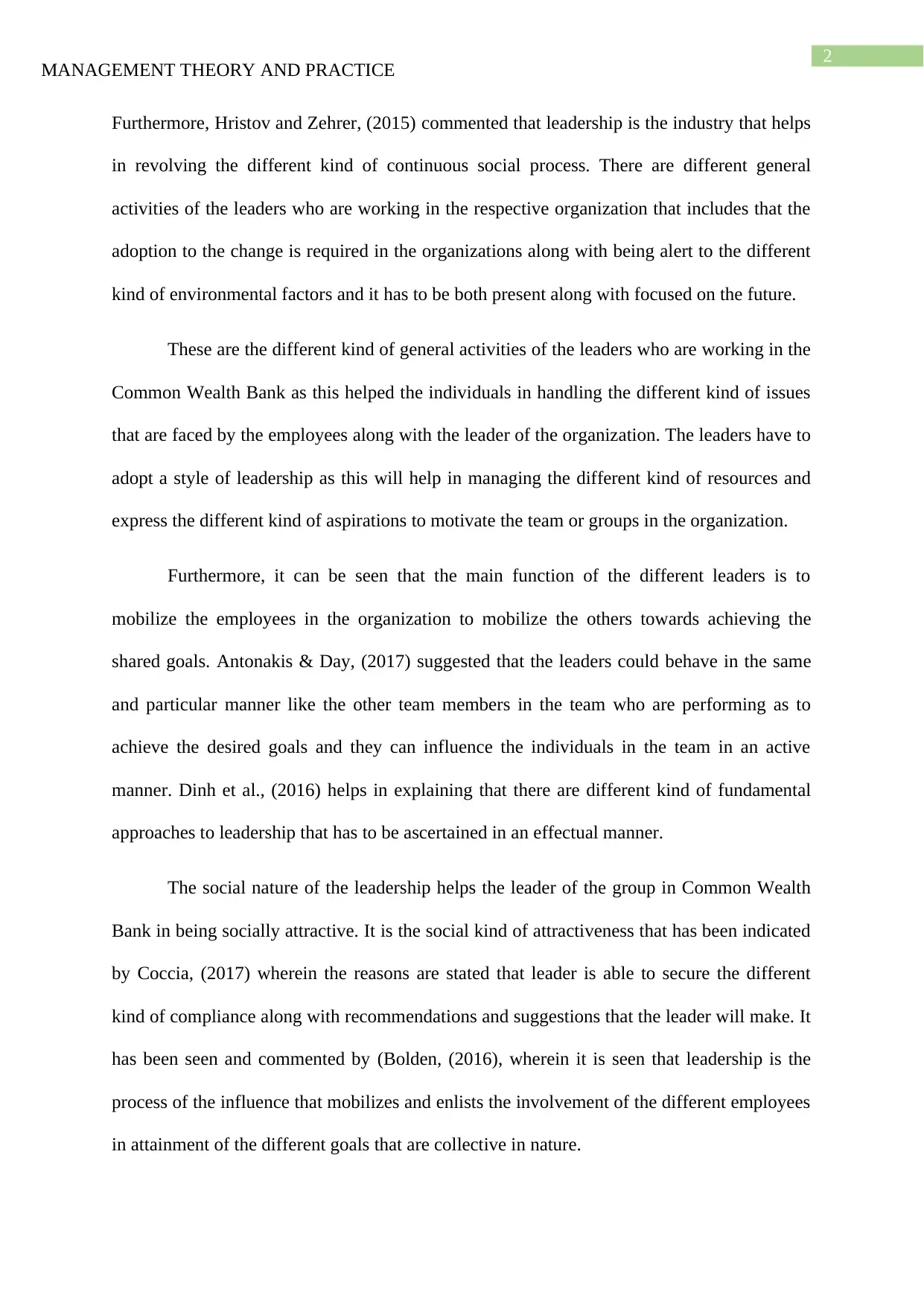
2
MANAGEMENT THEORY AND PRACTICE
Furthermore, Hristov and Zehrer, (2015) commented that leadership is the industry that helps
in revolving the different kind of continuous social process. There are different general
activities of the leaders who are working in the respective organization that includes that the
adoption to the change is required in the organizations along with being alert to the different
kind of environmental factors and it has to be both present along with focused on the future.
These are the different kind of general activities of the leaders who are working in the
Common Wealth Bank as this helped the individuals in handling the different kind of issues
that are faced by the employees along with the leader of the organization. The leaders have to
adopt a style of leadership as this will help in managing the different kind of resources and
express the different kind of aspirations to motivate the team or groups in the organization.
Furthermore, it can be seen that the main function of the different leaders is to
mobilize the employees in the organization to mobilize the others towards achieving the
shared goals. Antonakis & Day, (2017) suggested that the leaders could behave in the same
and particular manner like the other team members in the team who are performing as to
achieve the desired goals and they can influence the individuals in the team in an active
manner. Dinh et al., (2016) helps in explaining that there are different kind of fundamental
approaches to leadership that has to be ascertained in an effectual manner.
The social nature of the leadership helps the leader of the group in Common Wealth
Bank in being socially attractive. It is the social kind of attractiveness that has been indicated
by Coccia, (2017) wherein the reasons are stated that leader is able to secure the different
kind of compliance along with recommendations and suggestions that the leader will make. It
has been seen and commented by (Bolden, (2016), wherein it is seen that leadership is the
process of the influence that mobilizes and enlists the involvement of the different employees
in attainment of the different goals that are collective in nature.
MANAGEMENT THEORY AND PRACTICE
Furthermore, Hristov and Zehrer, (2015) commented that leadership is the industry that helps
in revolving the different kind of continuous social process. There are different general
activities of the leaders who are working in the respective organization that includes that the
adoption to the change is required in the organizations along with being alert to the different
kind of environmental factors and it has to be both present along with focused on the future.
These are the different kind of general activities of the leaders who are working in the
Common Wealth Bank as this helped the individuals in handling the different kind of issues
that are faced by the employees along with the leader of the organization. The leaders have to
adopt a style of leadership as this will help in managing the different kind of resources and
express the different kind of aspirations to motivate the team or groups in the organization.
Furthermore, it can be seen that the main function of the different leaders is to
mobilize the employees in the organization to mobilize the others towards achieving the
shared goals. Antonakis & Day, (2017) suggested that the leaders could behave in the same
and particular manner like the other team members in the team who are performing as to
achieve the desired goals and they can influence the individuals in the team in an active
manner. Dinh et al., (2016) helps in explaining that there are different kind of fundamental
approaches to leadership that has to be ascertained in an effectual manner.
The social nature of the leadership helps the leader of the group in Common Wealth
Bank in being socially attractive. It is the social kind of attractiveness that has been indicated
by Coccia, (2017) wherein the reasons are stated that leader is able to secure the different
kind of compliance along with recommendations and suggestions that the leader will make. It
has been seen and commented by (Bolden, (2016), wherein it is seen that leadership is the
process of the influence that mobilizes and enlists the involvement of the different employees
in attainment of the different goals that are collective in nature.
⊘ This is a preview!⊘
Do you want full access?
Subscribe today to unlock all pages.

Trusted by 1+ million students worldwide
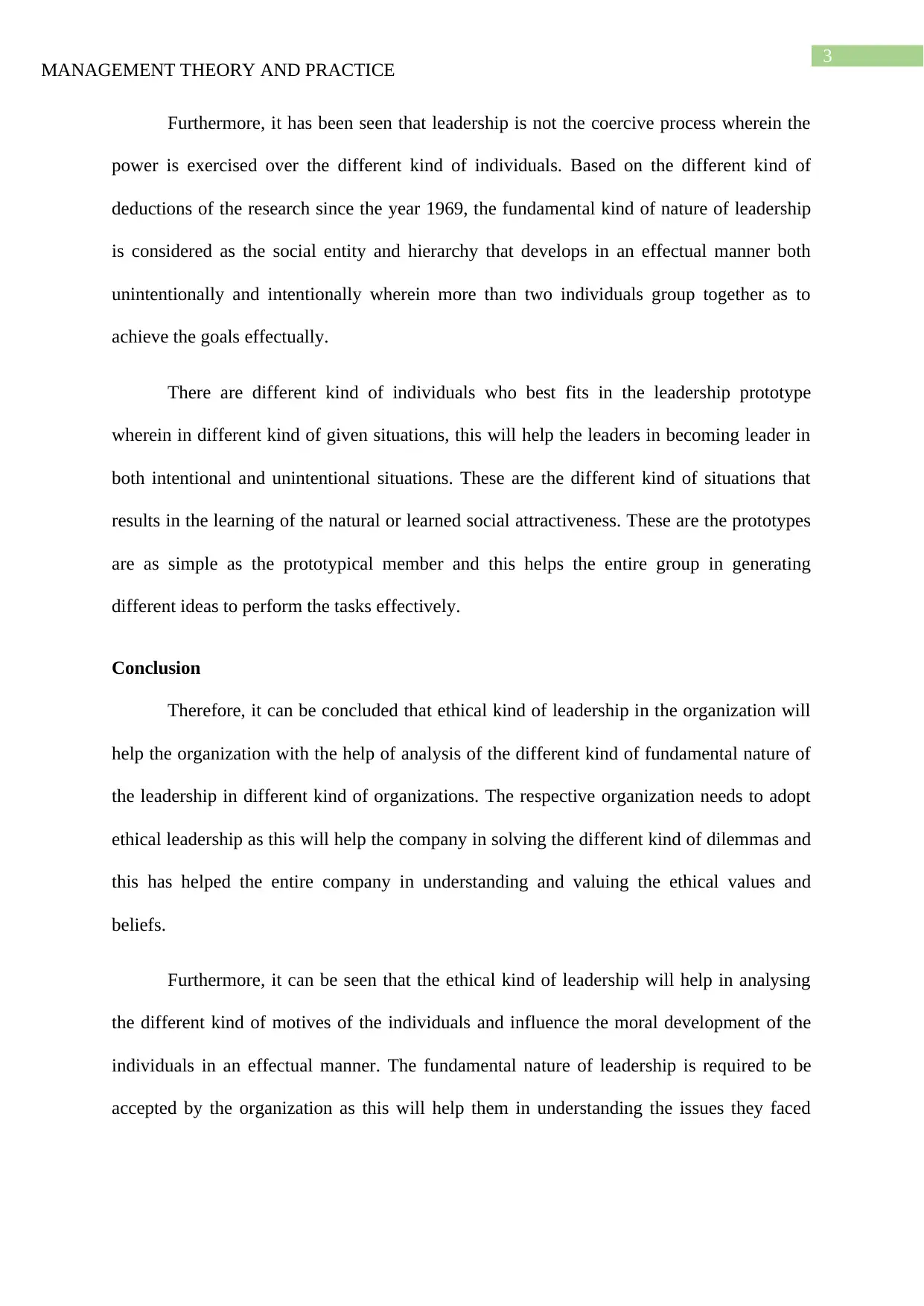
3
MANAGEMENT THEORY AND PRACTICE
Furthermore, it has been seen that leadership is not the coercive process wherein the
power is exercised over the different kind of individuals. Based on the different kind of
deductions of the research since the year 1969, the fundamental kind of nature of leadership
is considered as the social entity and hierarchy that develops in an effectual manner both
unintentionally and intentionally wherein more than two individuals group together as to
achieve the goals effectually.
There are different kind of individuals who best fits in the leadership prototype
wherein in different kind of given situations, this will help the leaders in becoming leader in
both intentional and unintentional situations. These are the different kind of situations that
results in the learning of the natural or learned social attractiveness. These are the prototypes
are as simple as the prototypical member and this helps the entire group in generating
different ideas to perform the tasks effectively.
Conclusion
Therefore, it can be concluded that ethical kind of leadership in the organization will
help the organization with the help of analysis of the different kind of fundamental nature of
the leadership in different kind of organizations. The respective organization needs to adopt
ethical leadership as this will help the company in solving the different kind of dilemmas and
this has helped the entire company in understanding and valuing the ethical values and
beliefs.
Furthermore, it can be seen that the ethical kind of leadership will help in analysing
the different kind of motives of the individuals and influence the moral development of the
individuals in an effectual manner. The fundamental nature of leadership is required to be
accepted by the organization as this will help them in understanding the issues they faced
MANAGEMENT THEORY AND PRACTICE
Furthermore, it has been seen that leadership is not the coercive process wherein the
power is exercised over the different kind of individuals. Based on the different kind of
deductions of the research since the year 1969, the fundamental kind of nature of leadership
is considered as the social entity and hierarchy that develops in an effectual manner both
unintentionally and intentionally wherein more than two individuals group together as to
achieve the goals effectually.
There are different kind of individuals who best fits in the leadership prototype
wherein in different kind of given situations, this will help the leaders in becoming leader in
both intentional and unintentional situations. These are the different kind of situations that
results in the learning of the natural or learned social attractiveness. These are the prototypes
are as simple as the prototypical member and this helps the entire group in generating
different ideas to perform the tasks effectively.
Conclusion
Therefore, it can be concluded that ethical kind of leadership in the organization will
help the organization with the help of analysis of the different kind of fundamental nature of
the leadership in different kind of organizations. The respective organization needs to adopt
ethical leadership as this will help the company in solving the different kind of dilemmas and
this has helped the entire company in understanding and valuing the ethical values and
beliefs.
Furthermore, it can be seen that the ethical kind of leadership will help in analysing
the different kind of motives of the individuals and influence the moral development of the
individuals in an effectual manner. The fundamental nature of leadership is required to be
accepted by the organization as this will help them in understanding the issues they faced
Paraphrase This Document
Need a fresh take? Get an instant paraphrase of this document with our AI Paraphraser
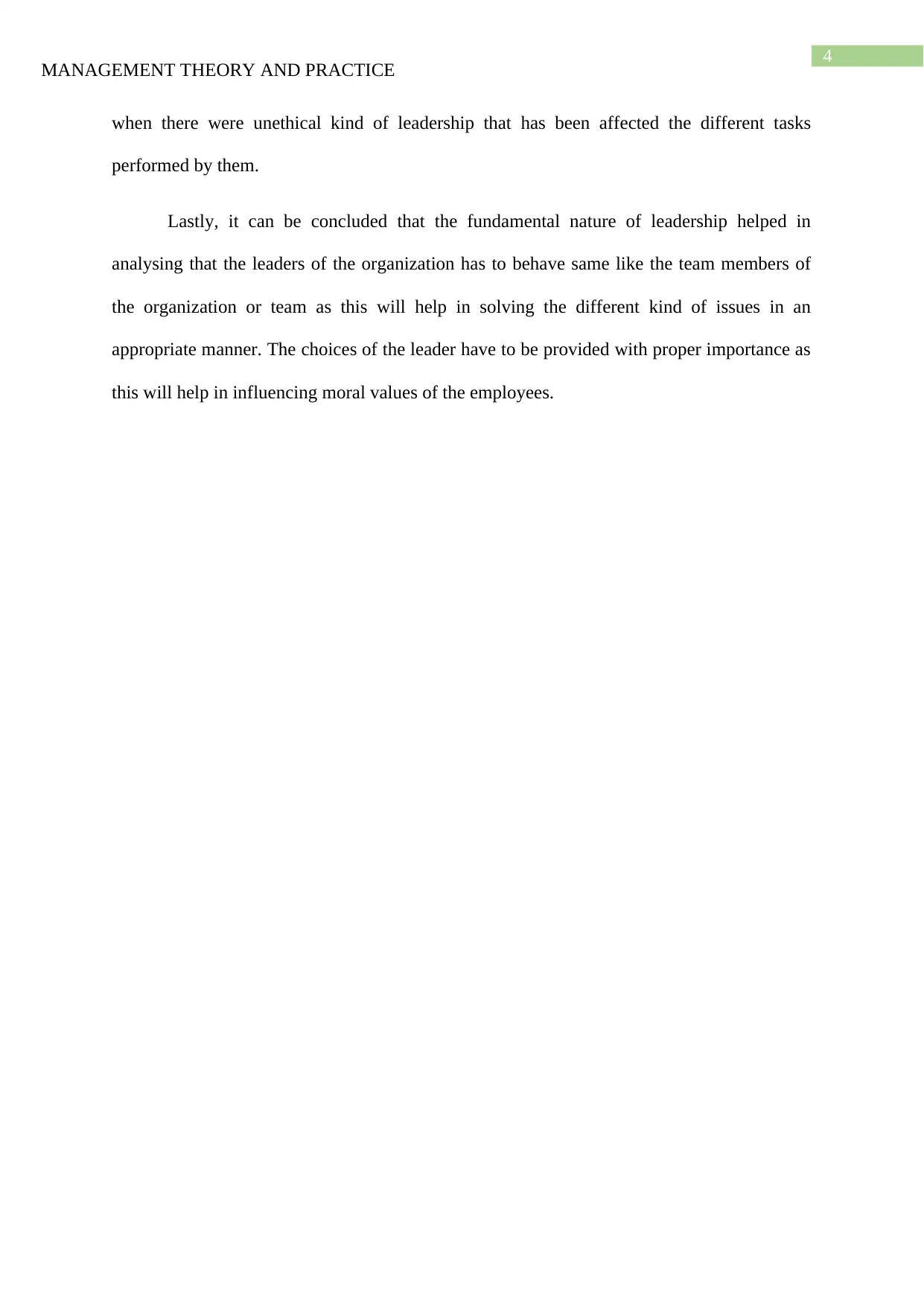
4
MANAGEMENT THEORY AND PRACTICE
when there were unethical kind of leadership that has been affected the different tasks
performed by them.
Lastly, it can be concluded that the fundamental nature of leadership helped in
analysing that the leaders of the organization has to behave same like the team members of
the organization or team as this will help in solving the different kind of issues in an
appropriate manner. The choices of the leader have to be provided with proper importance as
this will help in influencing moral values of the employees.
MANAGEMENT THEORY AND PRACTICE
when there were unethical kind of leadership that has been affected the different tasks
performed by them.
Lastly, it can be concluded that the fundamental nature of leadership helped in
analysing that the leaders of the organization has to behave same like the team members of
the organization or team as this will help in solving the different kind of issues in an
appropriate manner. The choices of the leader have to be provided with proper importance as
this will help in influencing moral values of the employees.
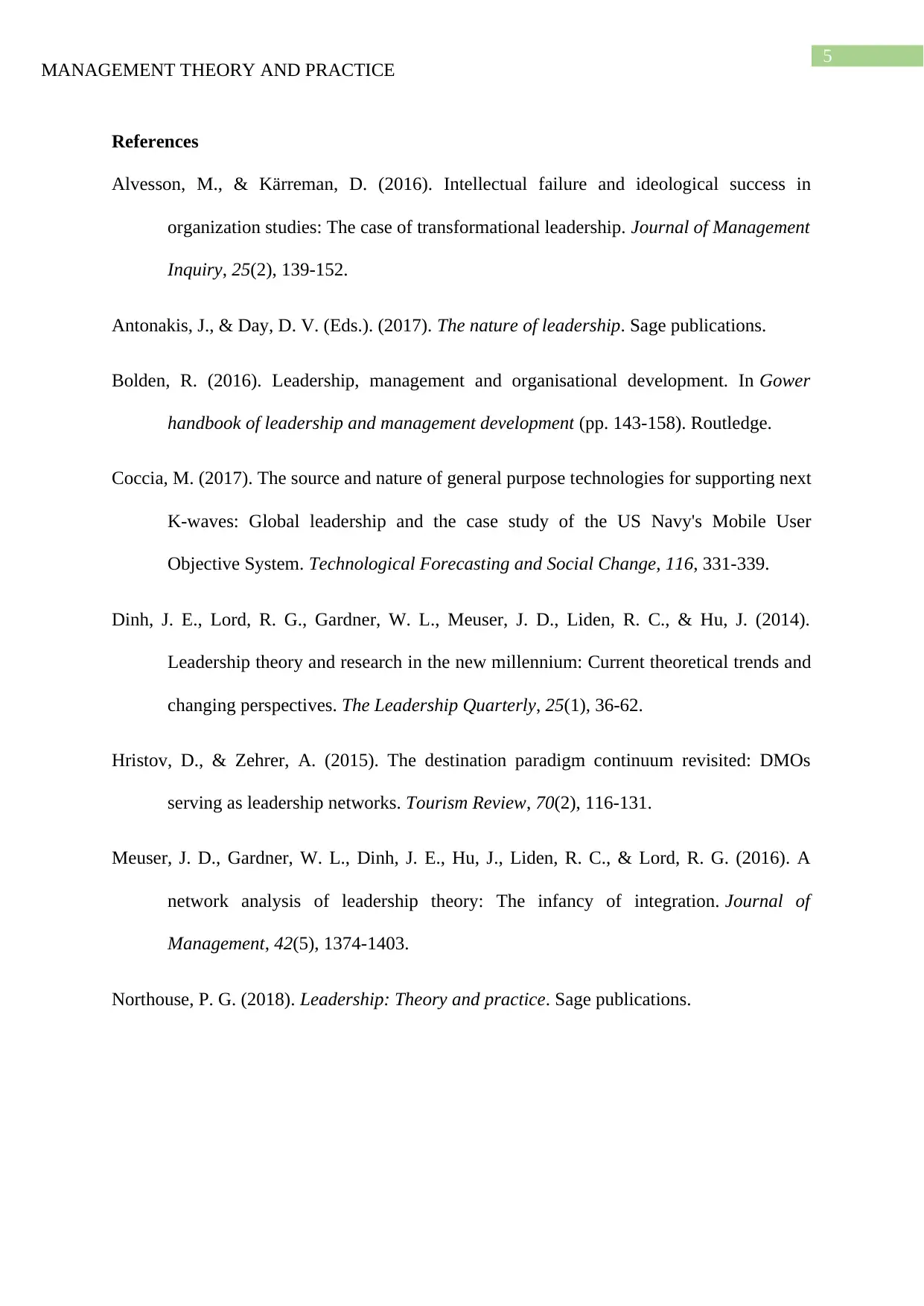
5
MANAGEMENT THEORY AND PRACTICE
References
Alvesson, M., & Kärreman, D. (2016). Intellectual failure and ideological success in
organization studies: The case of transformational leadership. Journal of Management
Inquiry, 25(2), 139-152.
Antonakis, J., & Day, D. V. (Eds.). (2017). The nature of leadership. Sage publications.
Bolden, R. (2016). Leadership, management and organisational development. In Gower
handbook of leadership and management development (pp. 143-158). Routledge.
Coccia, M. (2017). The source and nature of general purpose technologies for supporting next
K-waves: Global leadership and the case study of the US Navy's Mobile User
Objective System. Technological Forecasting and Social Change, 116, 331-339.
Dinh, J. E., Lord, R. G., Gardner, W. L., Meuser, J. D., Liden, R. C., & Hu, J. (2014).
Leadership theory and research in the new millennium: Current theoretical trends and
changing perspectives. The Leadership Quarterly, 25(1), 36-62.
Hristov, D., & Zehrer, A. (2015). The destination paradigm continuum revisited: DMOs
serving as leadership networks. Tourism Review, 70(2), 116-131.
Meuser, J. D., Gardner, W. L., Dinh, J. E., Hu, J., Liden, R. C., & Lord, R. G. (2016). A
network analysis of leadership theory: The infancy of integration. Journal of
Management, 42(5), 1374-1403.
Northouse, P. G. (2018). Leadership: Theory and practice. Sage publications.
MANAGEMENT THEORY AND PRACTICE
References
Alvesson, M., & Kärreman, D. (2016). Intellectual failure and ideological success in
organization studies: The case of transformational leadership. Journal of Management
Inquiry, 25(2), 139-152.
Antonakis, J., & Day, D. V. (Eds.). (2017). The nature of leadership. Sage publications.
Bolden, R. (2016). Leadership, management and organisational development. In Gower
handbook of leadership and management development (pp. 143-158). Routledge.
Coccia, M. (2017). The source and nature of general purpose technologies for supporting next
K-waves: Global leadership and the case study of the US Navy's Mobile User
Objective System. Technological Forecasting and Social Change, 116, 331-339.
Dinh, J. E., Lord, R. G., Gardner, W. L., Meuser, J. D., Liden, R. C., & Hu, J. (2014).
Leadership theory and research in the new millennium: Current theoretical trends and
changing perspectives. The Leadership Quarterly, 25(1), 36-62.
Hristov, D., & Zehrer, A. (2015). The destination paradigm continuum revisited: DMOs
serving as leadership networks. Tourism Review, 70(2), 116-131.
Meuser, J. D., Gardner, W. L., Dinh, J. E., Hu, J., Liden, R. C., & Lord, R. G. (2016). A
network analysis of leadership theory: The infancy of integration. Journal of
Management, 42(5), 1374-1403.
Northouse, P. G. (2018). Leadership: Theory and practice. Sage publications.
⊘ This is a preview!⊘
Do you want full access?
Subscribe today to unlock all pages.

Trusted by 1+ million students worldwide
1 out of 6
Related Documents
Your All-in-One AI-Powered Toolkit for Academic Success.
+13062052269
info@desklib.com
Available 24*7 on WhatsApp / Email
![[object Object]](/_next/static/media/star-bottom.7253800d.svg)
Unlock your academic potential
Copyright © 2020–2025 A2Z Services. All Rights Reserved. Developed and managed by ZUCOL.




